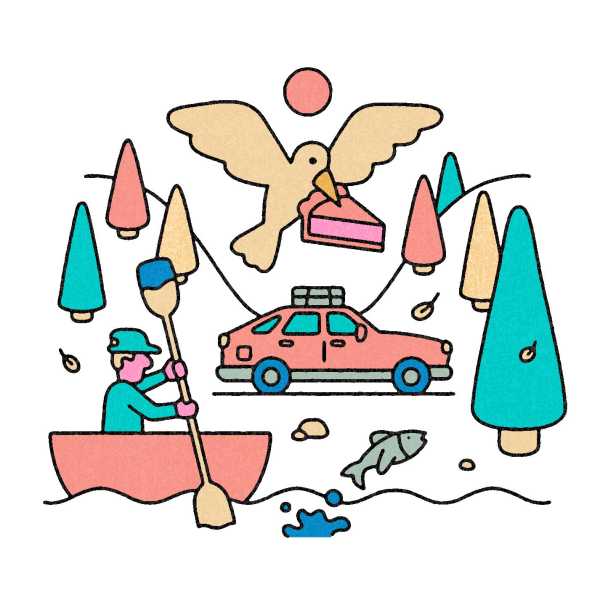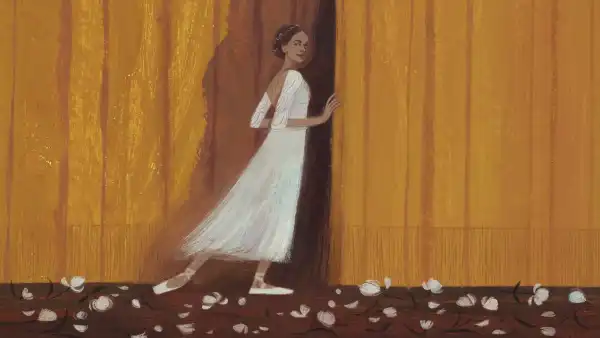
Save this storySave this storySave this storySave this storyYou’re reading the Goings On newsletter, a guide to what we’re watching, listening to, and doing this week. Sign up to receive it in your inbox.
In the spirit of summer travel, we’ve asked some of our writers living outside New York City to share a few of their favorite local spots. Read Lauren Collins on an irresistible Parisian toy store; Hannah Goldfield on her search for a prized fruit in Hollywood; Rebecca Mead on a beloved church grounds in London; Inkoo Kang on a quirky hyper-local perfume museum in Berkeley; and Ian Crouch on a mid-Maine nature sanctuary, with pie.—Shauna Lyon

Local Gems
Lauren Collins, in Paris

Illustrations by Jackson Gibbs
Toy stores—do those even exist anymore? I can vouch for at least one: Le Bruit du Papier, a small but mighty wonderland in the Ninth Arrondissement, strategically located directly across the street from the rec center where the kids in my neighborhood go to do judo or learn how to play the violin. This is essentially the same concept as putting a bar across from a golf course. No child can walk past the gleaming, apple-red storefront without pressing a nose to the glass and begging to be allowed to go in. What I love about Le Bruit du Papier is what I hate about Le Bruit du Papier. Its proprietor, Myriam Arthaud, knows exactly what her junior customers want. They come in packs, bearing old-school pocket money. (Coins! At Le Bruit du Papier, those are still going strong, too.) They spree on iced-tea-flavored “soda spray,” gelatinous candy eyeballs, capybara-shaped smooshies, One Piece branded Métro-card holders, and—most important—all things Legami, a Milanese maker of animal-topped pens, cutesy erasers, and other adorable crap that is all the rage with tiny Parisian shoppers. This being a French toy store, Arthaud does offer the occasional sop to adults. “There will be soft drinks for the youth and the more sober,” an invitation from the shop read, inviting patrons to come sample the new Beaujolais one recent evening. Dream on, Amazon.
Inkoo Kang, in Berkeley
The perfumer Mandy Aftel’s embrace of natural ingredients makes her an anomaly in the fragrance industry, which relies overwhelmingly on synthetic concoctions for its wares. Aftel, who has authored half a dozen books on the art, history, and uses of scent, shares her passion for olfactory possibility through the Aftel Archive of Curious Scents, the only museum in America dedicated to perfume. Operating out of the garage and back yard of her Berkeley home (a block over from Chez Panisse), it is a cozy, family-run affair; on a recent visit, between chats with Aftel herself, I was greeted by her husband and regaled with stories by her son. The museum’s collection includes centuries-old books and a bottle of ambergris (a substance produced in the digestive system of sperm whales), as well as elaborations on perfume’s long history. There are dozens of jars filled with essences that visitors are encouraged to sniff for themselves; my favorites included civet, cassia, and oud. One smelling station presents the ancient and modern extracts of the same plant for comparison. And, because smells are powerful but fleeting, guests can take home samples from the more than two hundred scents in Aftel’s work station, or, as it’s known in the fragrance world, perfume organ. With the Archive, Aftel has created a treasure trove of fragrances that may otherwise be difficult if not impossible to find—and, more important, she has created an opportunity to reorient one’s senses to the world.

Ian Crouch, in Maine
Look out from atop Table Rock, a wide perch on the northern end of Grafton Notch State Park, in western Maine (less than two hours northwest of Portland), and you might succumb, for a moment at least, to the foolishness of thinking you’ve got things figured out. It’s a nice spot, nicer than most, and you’re standing on it. Then again, having climbed about a thousand feet of trail in less than a mile, heart still pulsing at your temples, maybe you won’t be thinking at all. Even better! The black flies pierce the reverie through late June, but by July (real summer) you can linger to watch the clouds glide along, casting cool soft shadows on the distant ground, where a thin line of pavement snakes through the trees. And then, in the fall, probably having to make space for some neighbors up there—fellow-peepers—sit on the rock and hug your knees as all around the leaves go yellow, orange, red, and purple. Return to the car, head south a few miles, and pull off at Screw Auger Falls, or someplace quieter, to wash the mud off your calves in the icy Bear River. Change into the clean extra shirt you remembered to pack. Back on the road, still heading south, make one final stop, on the right: the Puzzle Mountain Bakery, in its third decade and under the stewardship of a second generation, named after a peak you just passed (more ledges, more views). It’s a pie stand, or, really, a pie hutch—a red wooden enclosure full of homemade fruit pies, maple-cream cookies, whoopie pies, and jam. They do their baking in a building down a nearby driveway, but the hutch is unmanned, and hours, Thursdays to Mondays, are flexible: cash goes in an old cast-iron tank (or Venmo if you must). There’s no bad time for pie, but there are few better times than this, sitting on the back bumper, passing tins of strawberry rhubarb, blueberry, and apple back and forth. Fingers, or maybe one fork. It’s getting late. Wipe the crumbs off your lap, wrap any leftovers for later, and start the long, or, for the lucky, shortish drive home.
Rebecca Mead, in London
When I moved to London from New York in 2018, I was struck by the city’s palpable sense of layered history, such as can be found by St. Pancras Old Church, just south of Camden Town, whose surroundings comprise a peaceful wedge of green alongside train tracks that lead to both the Midlands and to continental Europe. The majority of the diminutive church’s structure dates to the nineteenth century, but legend claims it as a site of worship since the Romans ruled Britain, while architectural evidence dates it to at least the Anglo-Saxon period, when the River Fleet, long since channelled underground, ran alongside it. In the nineteenth century, the church graveyard was excavated for the coming railway—a gruesome process overseen by a young architect who later became a great novelist, Thomas Hardy. Remains were dug up and transferred elsewhere, while dozens of displaced gravestones were stacked around an ash tree that became known as the Hardy Tree. A couple of years ago, the tree collapsed, on account of disease, and now, amid birdsong and leaf-whisper, the concentric circles of stones, shifted by roots and overgrown with moss, have become a memorial to the organism that once supported them. Elsewhere in the cemetery, an ornate tower topped with a sundial commemorates some others whose final resting place this once was. In a way that I find oddly comforting, it cites “those whose graves are now unseen, or the record of whose names may have been obliterated”—the ultimate fate of all Londoners, and of us all, as the layered past accretes.
Hannah Goldfield, in L.A.

I’m only a little embarrassed to admit that on a recent spring Sunday at the weekly Hollywood Farmers’ Market—a sprawling village that seems to materialize out of nowhere, oasis-like, at the rather grim intersection of two concrete thoroughfares—the bounty produced by the fertile valleys of Southern California moved me to joyful tears. Weiser, a farm known especially for its melons, was offering lush bouquets of pea shoots, delicate white flowers and crisp, shapely pods sprouting from curling tendrils, pretty enough to display in a vase. At a stall selling avocados, the vender took highly specific requests, sorting through his bins for specimens of varying size and ripeness. When he noticed my two small children lurking behind me, growing pink and sweaty in the relentless sun and itching to get to the man, a few stalls down, who makes custom balloon creations for tips, he proffered a gift: two of the most miniature of his harvest, each no bigger than a hen’s egg. For months, I’ve been anticipating—patiently, religiously—the return of the Valencia Pride mango grown by Wong Farms, in the Coachella Valley, which bears an almost psychedelically concentrated flavor. This past September, on the final day Wong was selling them at the market, I waited in a line that was at least fifty people deep. By the time I reached the front, they were sold out, but rather than annoyance I felt a surprising sense of peace, a camaraderie with my fellow-shoppers, and a certainty that something else spectacular would be just around the corner.
P.S. Good stuff on the internet:
- Sex after sixty
- The joy of sitting this one out
- Seeing the world like Slim Aarons
Sourse: newyorker.com







